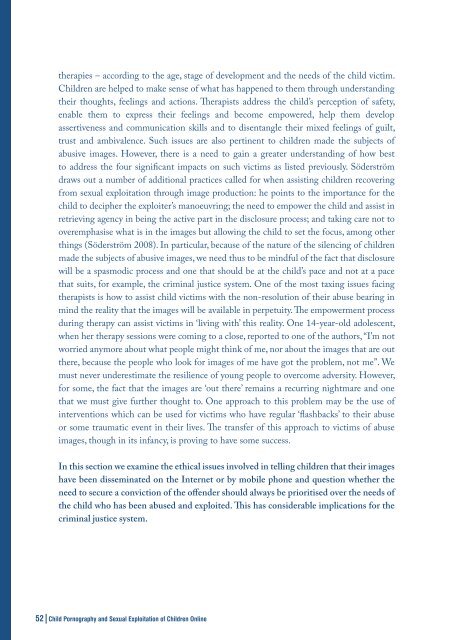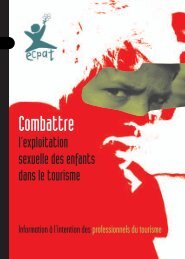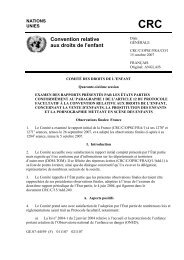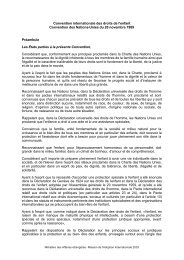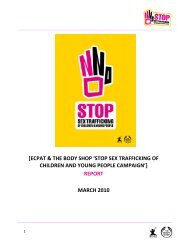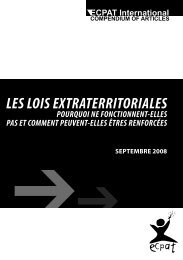child pornography and sexual exploitation of children online
child pornography and sexual exploitation of children online
child pornography and sexual exploitation of children online
Create successful ePaper yourself
Turn your PDF publications into a flip-book with our unique Google optimized e-Paper software.
therapies – according to the age, stage <strong>of</strong> development <strong>and</strong> the needs <strong>of</strong> the <strong>child</strong> victim.<br />
Children are helped to make sense <strong>of</strong> what has happened to them through underst<strong>and</strong>ing<br />
their thoughts, feelings <strong>and</strong> actions. Therapists address the <strong>child</strong>’s perception <strong>of</strong> safety,<br />
enable them to express their feelings <strong>and</strong> become empowered, help them develop<br />
assertiveness <strong>and</strong> communication skills <strong>and</strong> to disentangle their mixed feelings <strong>of</strong> guilt,<br />
trust <strong>and</strong> ambivalence. Such issues are also pertinent to <strong>child</strong>ren made the subjects <strong>of</strong><br />
abusive images. However, there is a need to gain a greater underst<strong>and</strong>ing <strong>of</strong> how best<br />
to address the four significant impacts on such victims as listed previously. Söderström<br />
draws out a number <strong>of</strong> additional practices called for when assisting <strong>child</strong>ren recovering<br />
from <strong>sexual</strong> <strong>exploitation</strong> through image production: he points to the importance for the<br />
<strong>child</strong> to decipher the exploiter’s manoeuvring; the need to empower the <strong>child</strong> <strong>and</strong> assist in<br />
retrieving agency in being the active part in the disclosure process; <strong>and</strong> taking care not to<br />
overemphasise what is in the images but allowing the <strong>child</strong> to set the focus, among other<br />
things (Söderström 2008). In particular, because <strong>of</strong> the nature <strong>of</strong> the silencing <strong>of</strong> <strong>child</strong>ren<br />
made the subjects <strong>of</strong> abusive images, we need thus to be mindful <strong>of</strong> the fact that disclosure<br />
will be a spasmodic process <strong>and</strong> one that should be at the <strong>child</strong>’s pace <strong>and</strong> not at a pace<br />
that suits, for example, the criminal justice system. One <strong>of</strong> the most taxing issues facing<br />
therapists is how to assist <strong>child</strong> victims with the non-resolution <strong>of</strong> their abuse bearing in<br />
mind the reality that the images will be available in perpetuity. The empowerment process<br />
during therapy can assist victims in ‘living with’ this reality. One 14-year-old adolescent,<br />
when her therapy sessions were coming to a close, reported to one <strong>of</strong> the authors, “I’m not<br />
worried anymore about what people might think <strong>of</strong> me, nor about the images that are out<br />
there, because the people who look for images <strong>of</strong> me have got the problem, not me”. We<br />
must never underestimate the resilience <strong>of</strong> young people to overcome adversity. However,<br />
for some, the fact that the images are ‘out there’ remains a recurring nightmare <strong>and</strong> one<br />
that we must give further thought to. One approach to this problem may be the use <strong>of</strong><br />
interventions which can be used for victims who have regular ‘flashbacks’ to their abuse<br />
or some traumatic event in their lives. The transfer <strong>of</strong> this approach to victims <strong>of</strong> abuse<br />
images, though in its infancy, is proving to have some success.<br />
In this section we examine the ethical issues involved in telling <strong>child</strong>ren that their images<br />
have been disseminated on the Internet or by mobile phone <strong>and</strong> question whether the<br />
need to secure a conviction <strong>of</strong> the <strong>of</strong>fender should always be prioritised over the needs <strong>of</strong><br />
the <strong>child</strong> who has been abused <strong>and</strong> exploited. This has considerable implications for the<br />
criminal justice system.<br />
52|Child Pornography <strong>and</strong> Sexual Exploitation <strong>of</strong> Children Online


